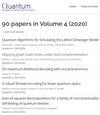A healthier semi-classical dynamics
IF 5.1
2区 物理与天体物理
Q1 PHYSICS, MULTIDISCIPLINARY
引用次数: 0
Abstract
We study the back-reaction of quantum systems onto classical ones. Taking the starting point that semi-classical physics should be described at all times by a point in classical phase space and a quantum state in Hilbert space, we consider an unravelling approach, describing the system in terms of a classical-quantum trajectory. We derive the general form of the dynamics under the assumptions that the classical trajectories are continuous and the evolution is autonomous, and the requirement that the dynamics is linear and completely positive in the combined classical-quantum state. This requirement is necessary in order to consistently describe probabilities, and forces the dynamics to be stochastic when the back-reaction is non-zero. The resulting equations of motion are natural generalisations of the standard semi-classical equations of motion, but since the resulting dynamics is linear in the combined classical-quantum state, it does not lead to the pathologies which usually follow from evolution laws based on expectation values. In particular, the evolution laws we present account for correlations between the classical and quantum system, which resolves issues associated with other semi-classical approaches. In addition, despite a breakdown of predictability in the classical degrees of freedom, the quantum state evolves deterministically conditioned on the classical trajectory, provided a trade-off between decoherence and diffusion is saturated. As a result, the quantum state remains pure when conditioned on the classical trajectory. To illustrate these points, we numerically simulate a number of semi-classical toy models, including one of vacuum fluctuations as a source driving the expansion of the universe. Finally, we discuss the application of these results to semi-classical gravity, and the black-hole information problem.更健康的半经典动力学
本文章由计算机程序翻译,如有差异,请以英文原文为准。
求助全文
约1分钟内获得全文
求助全文
来源期刊

Quantum
Physics and Astronomy-Physics and Astronomy (miscellaneous)
CiteScore
9.20
自引率
10.90%
发文量
241
审稿时长
16 weeks
期刊介绍:
Quantum is an open-access peer-reviewed journal for quantum science and related fields. Quantum is non-profit and community-run: an effort by researchers and for researchers to make science more open and publishing more transparent and efficient.
 求助内容:
求助内容: 应助结果提醒方式:
应助结果提醒方式:


